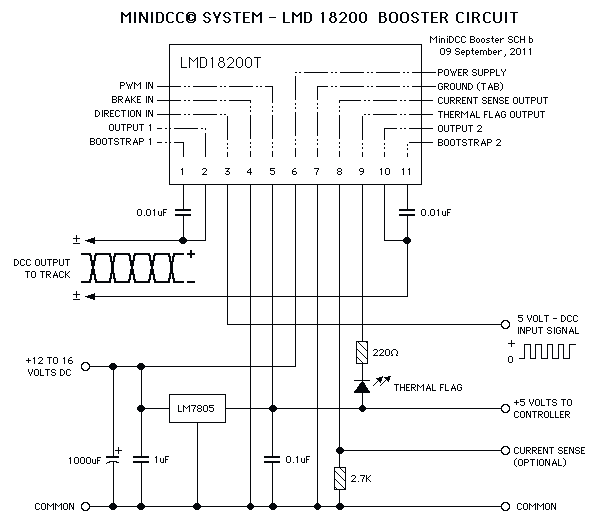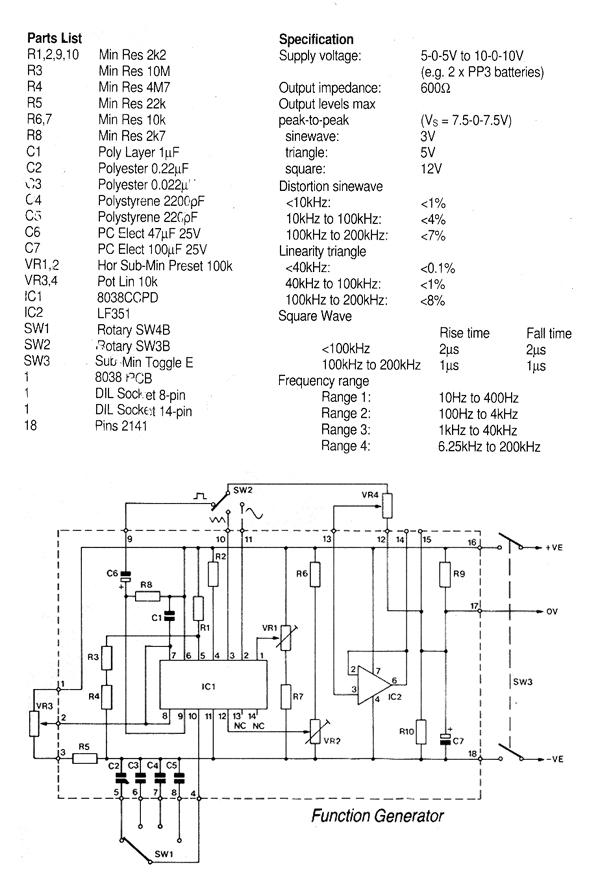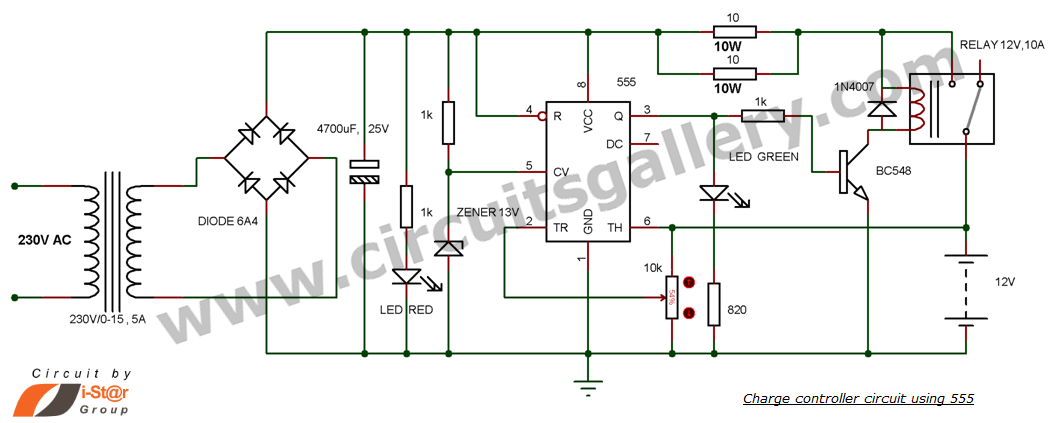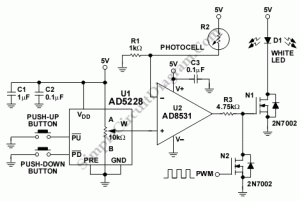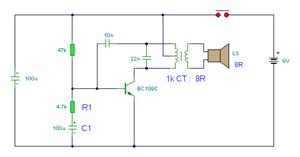
mini logger circuit
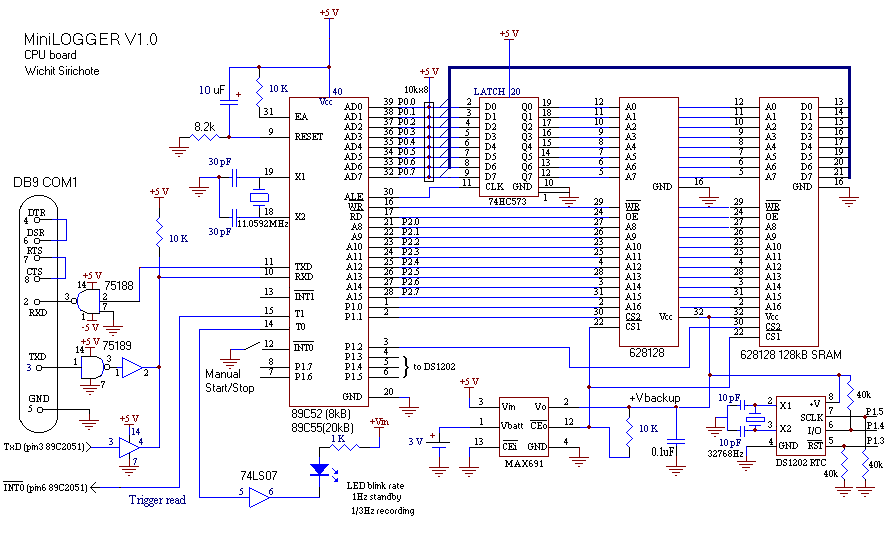
Build a personal data logger for recording analog signals. The MiniLOGGER provides 8-channel analog input (-99mV to +999mV), 1-channel pulse input, battery backup with 256kB SRAM, a Real-time Clock, and RS232C communication. Recording can be initiated or stopped using a manual switch or preprogrammed Start/Stop times. Data is uploaded in ASCII format, making it suitable for importing and graphing in Excel or any scientific plotting program. An exemplary circuit for measuring insolation and air temperature over time is included. The MiniLOGGER is designed as a data acquisition module for experiments, such as the "Long-term Evaluation of Grid Connected PV System." Previously, a signal conditioner board, known as Solar-Logger, utilized a chopper-stabilized DC amplifier for a Pyranometer, HALL sensor, LM35, and kWhr sensor. The firmware for Solar-Logger was written entirely in assembly code, making maintenance and modification challenging. Consequently, the decision was made to rewrite it in C and provide instructions for building a generic version, the MiniLOGGER, without the analog signal conditioner. Users interested in adapting the analog conditioning board for their experiments can easily do so. The circuit for the analog signal amplifier will be provided later. To operate the MiniLOGGER, a terminal emulation program such as HyperTerminal should be configured to 9600 bps, 8 data bits, no parity, and 1 stop bit, with Xon/Xoff flow control. After connecting the RS232C serial port of the MiniLOGGER to COM1 and powering it with a DC adapter, pressing enter will prompt the MiniLOGGER to send a title message. The `help` command provides a list of single-letter commands that the MiniLOGGER accepts. Manual START/STOP recording is the simplest method for standalone use, without connecting to a web server. A manual switch connected to pin P3.2 provides a logic '0' to start recording and a logic '1' to stop recording when opened. In this mode, the START/STOP TIME must be set to 99:99 to disable automatic mode. The sample interval saved in NVSRAM is retained when the LOGGER is powered up again. In automatic mode, the LOGGER starts recording when the clock from the DS1202 reaches the preset START time and stops when it reaches the preset STOP time. During recording, after each record is saved, the record number is transmitted through the TxD pin. In both modes, while in standby or stopped, the LED blinks at a rate of 1 Hz, and during recording, it blinks at 3 Hz. In manual mode, after setting the interval with the `i` command and setting the START/STOP TIME to 99:99 using a PC, the power supply can be turned off. The MiniLOGGER can then be taken to the experiment site, powered on, and recording initiated by closing the manual switch, causing the LED to blink every 3 seconds. After data logging is complete, the manual switch should be opened, the power turned off, and the device connected to a terminal for data upload using the `r` and `a` commands. Uploading and capturing recorded data can be accomplished using Capture Text. After naming the capture text file, entering `>>a` will save all records into capturefile.txt. Figure 5 illustrates a simple DC amplifier for the Pyranometer and LM35 temperature sensor IC. The amplifier is configured as a non-inverting DC amplifier using a chopperless precision op-amp, OP07. The Pyranometer's sensitivity is 14 µV/W/m², and to amplify it to 1 mV/W/m², the gain should be approximately 71. The gain of the non-inverting amplifier is approximately (1 + Rf/1k), where Rf is a 100k variable resistor. A 1k resistor and a 10 µF capacitor form a low-pass filter. The LM35 IC can measure air temperature easily; however, it is biased with a single-ended supply, allowing the circuit shown in Figure 5 to measure temperatures from 0 to 50 °C. The ASCII text file of the records can be easily imported into an Excel worksheet. Figure 8 provides an example graph.
The MiniLOGGER circuit design includes key components that facilitate data acquisition and processing. The 8-channel analog input allows for diverse signal monitoring, while the pulse input expands the functionality for digital signal capture. The 256kB SRAM ensures ample storage for recorded data, supporting long-term logging without the need for constant power. The Real-time Clock (RTC) is crucial for timestamping each data entry, enabling accurate time-based analysis.
The communication interface via RS232C allows for straightforward integration with computers and terminal emulation software, ensuring ease of data retrieval. The manual switch feature provides flexibility in operation, allowing users to initiate recording without needing a computer connection, which is beneficial for field applications.
The analog signal conditioning can be tailored to specific sensors, such as the Pyranometer and LM35, enhancing measurement accuracy. The use of a non-inverting amplifier configuration ensures that the signals from these sensors are amplified appropriately for the ADC input of the MiniLOGGER. The design considerations for filtering and gain adjustment are critical for achieving the desired sensitivity and precision in measurements.
Future enhancements could include the integration of additional communication protocols, such as USB or wireless connectivity, to streamline data transfer and improve user accessibility. Additionally, expanding the firmware capabilities to include more advanced data processing features could enhance the overall functionality of the MiniLOGGER, making it a versatile tool for various experimental applications.Build your own a personal data logger for recording analog signal. The MiniLOGGER provides 8-channel analog input(-99mV to +999mV), 1-channel pulse input, battery backup 256kB SRAM, Real-time Clock, and RS232C. Start/Stop recording can be made by MANUAL switch or preprogrammed Start/Stop Time. The format of uploading data is ASCII format, suitable for importing and graphing by Excel or any Scientific Plot Program. Exemplary circuit used for measuring Insolation and Air Temperature vs. Time is included. I have designed the MiniLOGGER to be used as a data acquisition module for my experiment, "Long-term Evaluation of Grid Connected PV System". Formerly, there`s a signal conditioner board having chopper stabilized DC amplifier for Pyranometer, HALL sensor, LM35, and kWhr sensor, it`s called Solar-Logger.
The firmware of Solar-Logger was written entirely in assembly code, very difficult for maintenance and modification. So I decided to rewrite using `C` and to provide this page describing how to build the generic part, without analog signal conditioner, with new name, the MiniLOGGER.
Those who interested, for her/his experiment can be made themselves, the analog conditioning board to suit their experiment easily. I shall provide the circuit of analog signal amplifier to be used with the MiniLOGGER on later. Run terminal emulation program, say HyperTerminal configured with 9600 bps 8n1, Xon/Xoff flow control, connect RS232C serial port of the MiniLOGGER to COM1.
After put a DC adapter, press enter, MiniLOGGER will send title message. Try with ` ` help command. The MiniLOGGER accepts single letter command as describe in help command. Manual START/STOP recording is the easiest way of using in standalone mode, i. e. , without connecting to web server. Manual switch connected to P3. 2 provides a logic `0` making the MiniLOGGER started to record and when open, P3. 2 be a logic `1`, stop recording. In this mode, user must set START/STOP TIME to 99:99 to disable automatic mode. The interval between sample that saved in NVSRAM is restored the last set when power up the LOGGER again. In Automatic mode, the LOGGER will start record when time of clock read from DS1202 is equal to preset START time and stop record when equal to preset STOP time.
During in recording, after finish saving each record, the number of record will send through TxD pin. In both mode, while in standby or stop recording, the LED will blink at 1Hz rate, but while recording, the blink rate will be 3Hz.
When using manual mode, after setting interval with `i` command, and set START/STOP TIME to 99:99 by using a PC, we may turn the power supply off. Take the MiniLOGGER to the place for experiment, turn the power on, the LED will blink at 1Hz rate. To start recording, just close MANUAL switch, the LED will blink every 3 sec. When finished logging the data, turn MANUAL switch open, turn the power off, take to the lab connecting to a terminal for uploading with `r` and `a` command.
Uploading and capturing the recorded data is easily be made by using Capture Text. After put a name of capture text file, enter >>a, All read command, all records will then be saved into capturefile. txt Figure 5 depicts a simple DC amplifier for Pyranometer and LM35 temperature sensor IC. The amplifier is configured to be non-inverting DC amplifier using chopperless precision opamp, OP07.
The sensitivity of Pyranometer is 14uV/ W/m2, to amplify for 1mV/W/m2, the gain should be approx. 71. Since the gain of noninverting type is approx. (1+Rf/1k), where Rf is 10 turn 100k variable resistor. A 1k and 10uF forms a low-pass filter. Air temperature is easily be measured by using LM35 IC. However, biasing of the LM35 is done with single-end supply, thus the circuit shown in Figure 5 can be used for measuring temperature from 0 - 50C, say. The ASCII text file of the record can be easily imported into Excel worksheet. Figure 8 shows example grap 🔗 External reference
The MiniLOGGER circuit design includes key components that facilitate data acquisition and processing. The 8-channel analog input allows for diverse signal monitoring, while the pulse input expands the functionality for digital signal capture. The 256kB SRAM ensures ample storage for recorded data, supporting long-term logging without the need for constant power. The Real-time Clock (RTC) is crucial for timestamping each data entry, enabling accurate time-based analysis.
The communication interface via RS232C allows for straightforward integration with computers and terminal emulation software, ensuring ease of data retrieval. The manual switch feature provides flexibility in operation, allowing users to initiate recording without needing a computer connection, which is beneficial for field applications.
The analog signal conditioning can be tailored to specific sensors, such as the Pyranometer and LM35, enhancing measurement accuracy. The use of a non-inverting amplifier configuration ensures that the signals from these sensors are amplified appropriately for the ADC input of the MiniLOGGER. The design considerations for filtering and gain adjustment are critical for achieving the desired sensitivity and precision in measurements.
Future enhancements could include the integration of additional communication protocols, such as USB or wireless connectivity, to streamline data transfer and improve user accessibility. Additionally, expanding the firmware capabilities to include more advanced data processing features could enhance the overall functionality of the MiniLOGGER, making it a versatile tool for various experimental applications.Build your own a personal data logger for recording analog signal. The MiniLOGGER provides 8-channel analog input(-99mV to +999mV), 1-channel pulse input, battery backup 256kB SRAM, Real-time Clock, and RS232C. Start/Stop recording can be made by MANUAL switch or preprogrammed Start/Stop Time. The format of uploading data is ASCII format, suitable for importing and graphing by Excel or any Scientific Plot Program. Exemplary circuit used for measuring Insolation and Air Temperature vs. Time is included. I have designed the MiniLOGGER to be used as a data acquisition module for my experiment, "Long-term Evaluation of Grid Connected PV System". Formerly, there`s a signal conditioner board having chopper stabilized DC amplifier for Pyranometer, HALL sensor, LM35, and kWhr sensor, it`s called Solar-Logger.
The firmware of Solar-Logger was written entirely in assembly code, very difficult for maintenance and modification. So I decided to rewrite using `C` and to provide this page describing how to build the generic part, without analog signal conditioner, with new name, the MiniLOGGER.
Those who interested, for her/his experiment can be made themselves, the analog conditioning board to suit their experiment easily. I shall provide the circuit of analog signal amplifier to be used with the MiniLOGGER on later. Run terminal emulation program, say HyperTerminal configured with 9600 bps 8n1, Xon/Xoff flow control, connect RS232C serial port of the MiniLOGGER to COM1.
After put a DC adapter, press enter, MiniLOGGER will send title message. Try with ` ` help command. The MiniLOGGER accepts single letter command as describe in help command. Manual START/STOP recording is the easiest way of using in standalone mode, i. e. , without connecting to web server. Manual switch connected to P3. 2 provides a logic `0` making the MiniLOGGER started to record and when open, P3. 2 be a logic `1`, stop recording. In this mode, user must set START/STOP TIME to 99:99 to disable automatic mode. The interval between sample that saved in NVSRAM is restored the last set when power up the LOGGER again. In Automatic mode, the LOGGER will start record when time of clock read from DS1202 is equal to preset START time and stop record when equal to preset STOP time.
During in recording, after finish saving each record, the number of record will send through TxD pin. In both mode, while in standby or stop recording, the LED will blink at 1Hz rate, but while recording, the blink rate will be 3Hz.
When using manual mode, after setting interval with `i` command, and set START/STOP TIME to 99:99 by using a PC, we may turn the power supply off. Take the MiniLOGGER to the place for experiment, turn the power on, the LED will blink at 1Hz rate. To start recording, just close MANUAL switch, the LED will blink every 3 sec. When finished logging the data, turn MANUAL switch open, turn the power off, take to the lab connecting to a terminal for uploading with `r` and `a` command.
Uploading and capturing the recorded data is easily be made by using Capture Text. After put a name of capture text file, enter >>a, All read command, all records will then be saved into capturefile. txt Figure 5 depicts a simple DC amplifier for Pyranometer and LM35 temperature sensor IC. The amplifier is configured to be non-inverting DC amplifier using chopperless precision opamp, OP07.
The sensitivity of Pyranometer is 14uV/ W/m2, to amplify for 1mV/W/m2, the gain should be approx. 71. Since the gain of noninverting type is approx. (1+Rf/1k), where Rf is 10 turn 100k variable resistor. A 1k and 10uF forms a low-pass filter. Air temperature is easily be measured by using LM35 IC. However, biasing of the LM35 is done with single-end supply, thus the circuit shown in Figure 5 can be used for measuring temperature from 0 - 50C, say. The ASCII text file of the record can be easily imported into Excel worksheet. Figure 8 shows example grap 🔗 External reference
